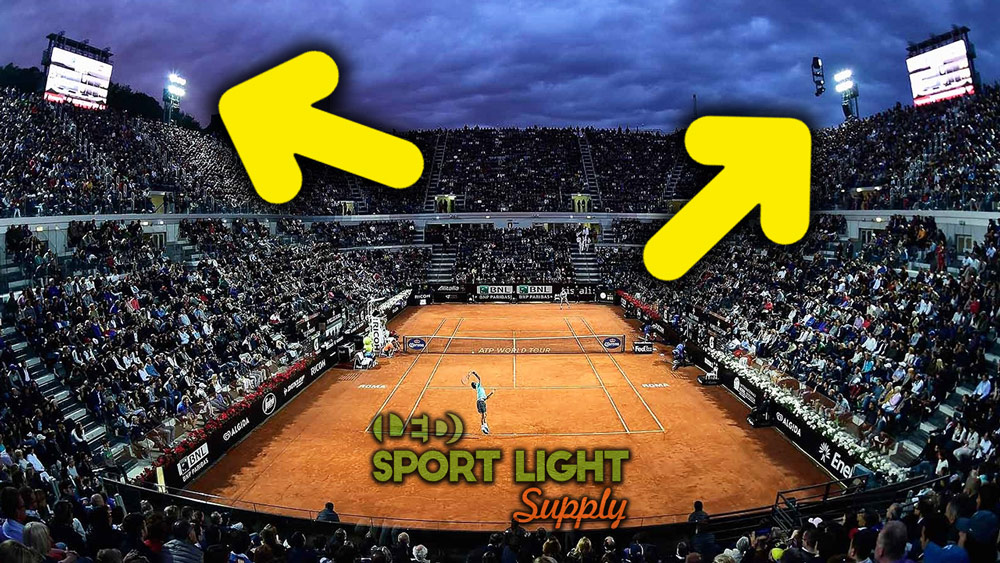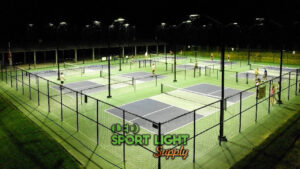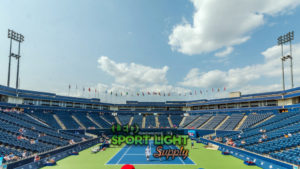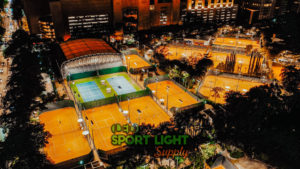The lightning-quick action of tennis is enjoyed all over the world for daytime play. When it comes to night time practice or active competition gaming, necessary lighting is just as critical. Get ready to get courtside for an inside look at LED tennis court lighting and understand how it improves visibility. Whether or not you like playing tennis inside or outside, you’ll learn more about lighting specifications that are industry standards now.
Tennis hasn’t changed much in the last 150 years, but the advancements lighting certainly have. Now tennis can be played in well-lit situations indoors and at night. What kind of benefits can you expect to find with the tennis court lighting layout these days? Read a bit more and find out why.
What is tennis court lighting?
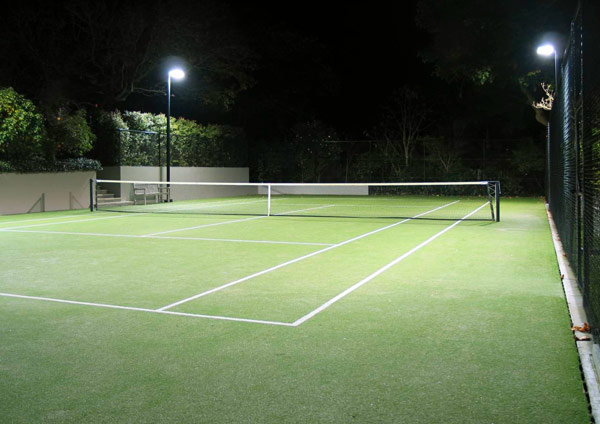 It’s hard to believe that it’s only been 45 years since the US Open began televising nighttime tennis matches in 1975. Earlier to that, history starts to get a bit murky, but there’s proof that night gaming started in 1879. Thanks to Thomas Edison’s lighting using a new carbon-thread incandescent bulb. In a friendly night-time match played behind a factory in Boston, three towers allowed a total of 90,000 candles worth!
It’s hard to believe that it’s only been 45 years since the US Open began televising nighttime tennis matches in 1975. Earlier to that, history starts to get a bit murky, but there’s proof that night gaming started in 1879. Thanks to Thomas Edison’s lighting using a new carbon-thread incandescent bulb. In a friendly night-time match played behind a factory in Boston, three towers allowed a total of 90,000 candles worth!
It was in 1929, that the NFL began playing under night-time floodlights until 1959; when metal halide lighting was invented. It was reported that this lighting was first extended to tennis court lighting and other various sports. This new lighting may have been used at private clubs, universities, and residence courts. But the first mention was in 1975. Tennis court lighting remained unchanged until mid-2010 when LED sports lighting came along.
Tennis court lighting is a serious science that integrates color balanced temperatures with industry standards. This lighting helps simulate daylight vision over the court so that players both receive equal light anywhere they play. This includes the service box to the defense zones and even spilling floodlights over the doubles sidelines. When it comes to professional competition, this light efficiency became more focused and technically advanced.
Why do we need tennis court lighting?
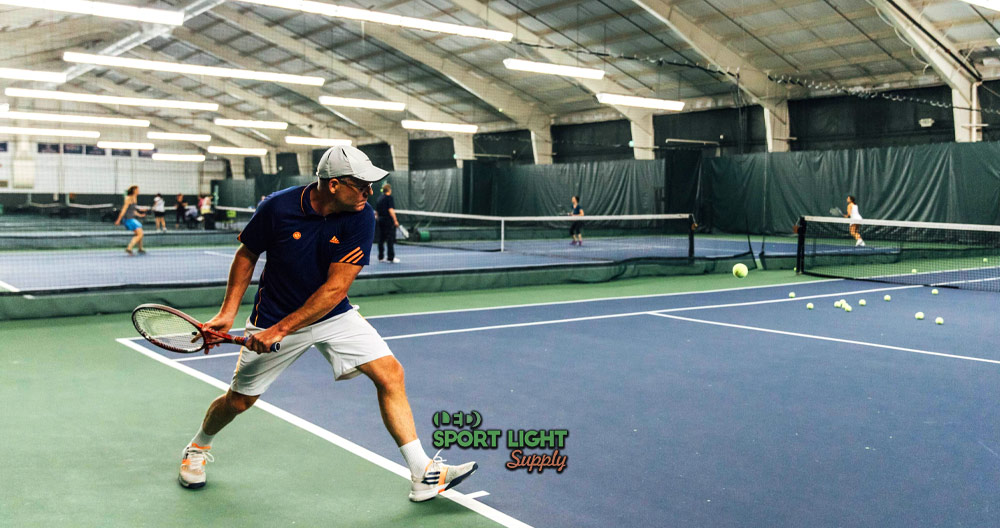
There are several reasons why a tennis court needs lighting since it would be so obvious. Areas that are void of natural light, including indoor courts or outdoors at night both need electric lighting. With the proper amount of light used, this gives better vision for players and spectators. Especially at locations where large audiences gather to watch competition tennis matches. Among the advantages of this lighting, it also allows television cameras and digital photos to be captured without losing quality.
No matter how far away the audience happens to be, seeing where the player is on the court is important. This is equally crucial for players spotting and tracking a fast-moving ball flying across their side. How the lighting is laid-out, the player will have equal amounts of focused light that has very few shadows. This also gives adequate lighting from all sides that overpower and cover repeat’ shadows that may form.
No matter if the lighting is used inside or outside, these colors can be balanced so they include the right CRI. This includes color temperature and color rendering index to determine the best vision levels possible for pro and semi-pro level tournaments. They aren’t limited to residential usage either, but depending on the need for high-quality lighting; these options are possible.
Types of tennis court lighting
1. Residential
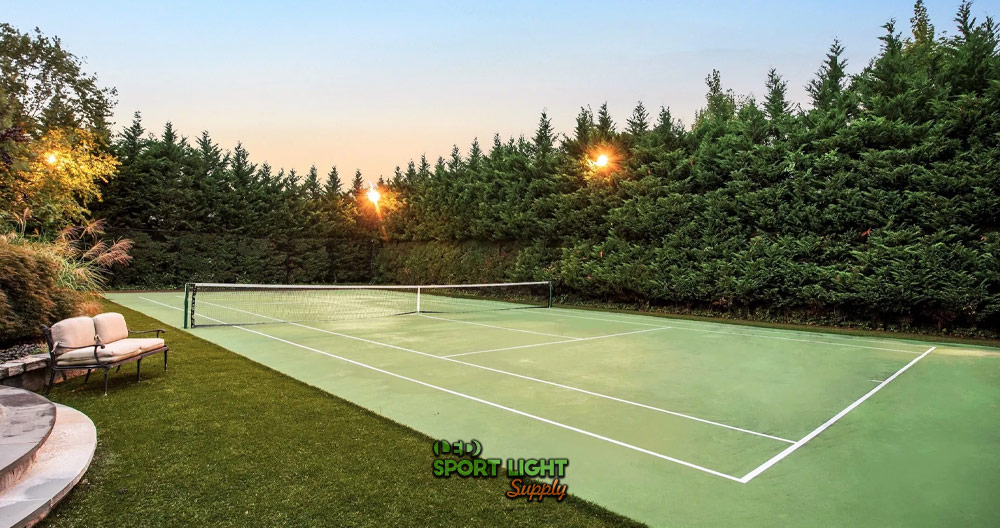
Many homes that have backyard courts don’t often put in lighting for night time use. But there are advantages to having lights installed since LED floodlights for tennis can extend your evening matches. Because LED lights use less wattage, you don’t have to sacrifice the brightness that makes LEDs beneficial.
2. Commercial
You’ll find commercial tennis courts in schools, tennis clubs, and outdoor recreation facilities nearly anywhere these days. Many of them make their courts as attractive to use by upgrading or retrofitting their lighting. Since these lights are meant for performance, the lighting is stronger as a result. There are much more refined levels of color temperature and CRI so they’re used for tournaments and semi-professional play too.
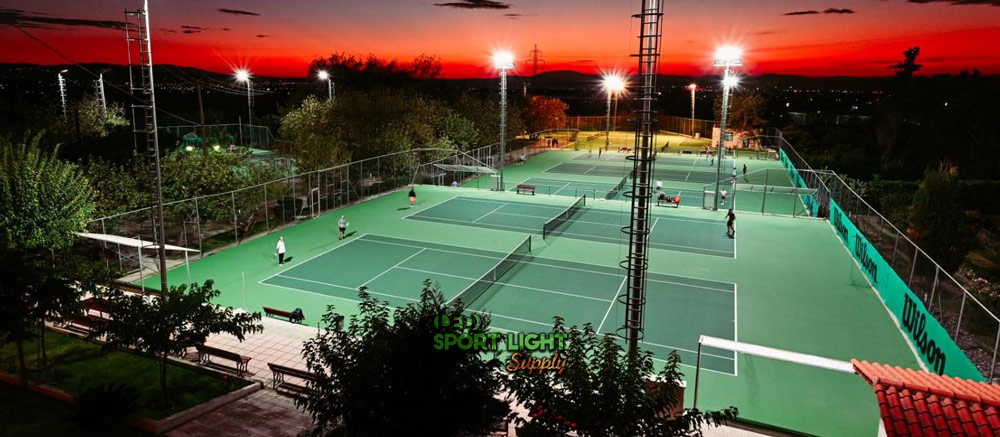
3. Outdoor tennis court lighting
Most outdoor tennis courts will have their lights mounted on poles just outside the court itself. Most of the newest outdoor panel designs also allow solar panels to charge external batteries to use lights at night. These can be mounted to a high mast pole or on a rooftop and provide 3.5 hours of electricity-free light. This is an excellent option in case of power outages likewise.
4. Indoor tennis court lighting
Indoor lighting is achieved by hanging or mounting light fixtures to suspension beams or mounting brackets on the ceiling. These can also be mounted to the upper edge of a wall instead of being directly overhead. In both cases, lighting can illuminate a tennis court to any degree whether it’s meant for competition or recreational pleasure.
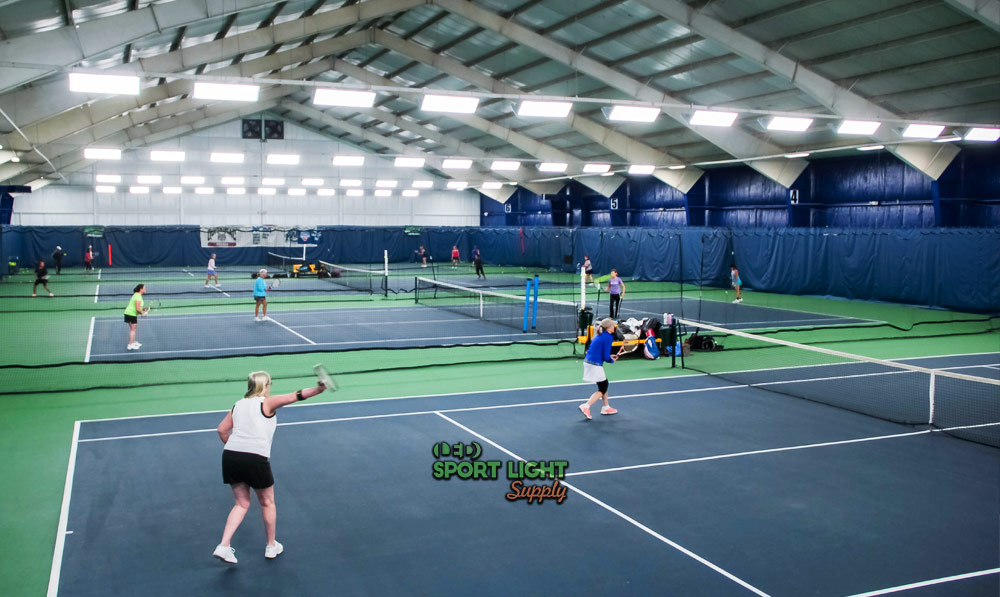
5. Portable tennis court lighting
In some cases, there’s a need to bring in extra light if locations are suitable if that court lighting isn’t. A portable light tower supplies the right amount of light to any location and is perfect for last-minute lighting needs. These mobile lights are ideal for television broadcasting since they carry high-powered LED lamps meant for sports lighting coverage.
Different classes of tennis court lighting
1. Class I
This is lighting that is reserved for professional level competitions including USTA, ITF, and supported by the US Open. This type of lighting only uses a specific spectrum of color temperature and has strict requirements for CRI, GR levels, and Lux ratings. Even the level of foot-candles is specific for night time games used for tennis court lighting.
2. Class II
These are reserved for college-level/challengers that are readily known as the semi-professionals in their league. This lighting is still very high in comparison but has slightly lover values when considering the number of foot-candles. The Class II’ level still retains the CRI, GR rating, and Lux rating to be used as a training tool.
3. Class III
This final level is applied to high school/private clubs but is still worthy of quality tennis lighting. The color temperature is a bit different while the CRI, GR rating and Lux rating all border-on just below semi-pro. The biggest difference is that these lights tend to be a cool white color instead of daylight.
4. Class IV
This is left-over for recreation centers, local city tennis courts, and open public courts. These are often a mixed bag of lighting that is not using top-quality lighting but is still fine for gameplay. Residential homes are not included since many of these private court owners will spend extra for pro-grade LED sports lighting.
Tennis court lighting design
According to IES standards, they have developed a standard level of adequate lighting that is meant for professional tennis players. These are further embraced by the USTA since the brightness requirements are all met. Yet there are more specific areas that follow a lighting design that is meant to improve visual performance. Among these standards will include a select amount of glare control, CRI, color temperature, and light uniformity.
Another issue that isn’t mentioned often is the visible amount of flicker. The newest models that are made for LED lighting have built-in flicker controls.
1. Light uniformity
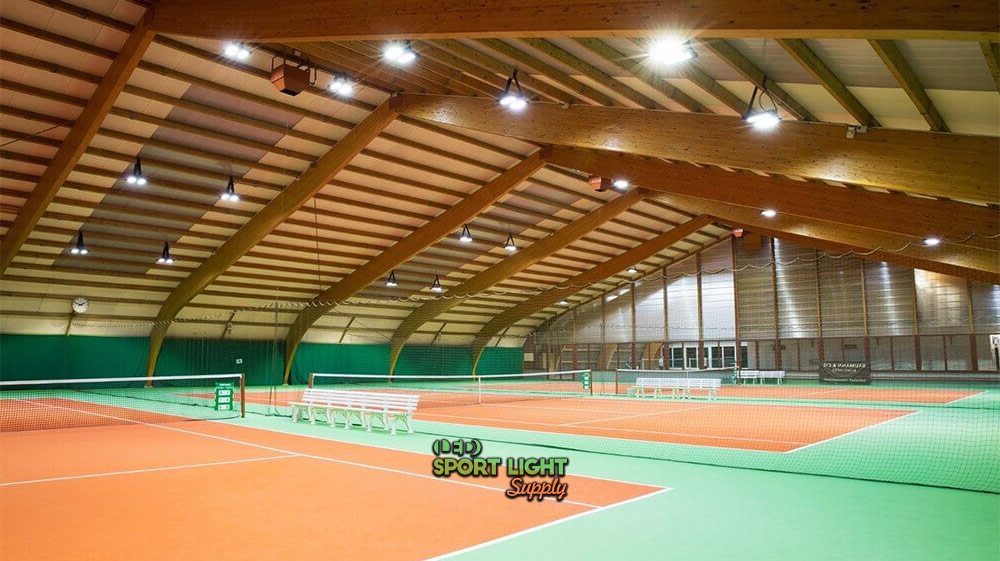
A tennis court is lit with LED light using a method that helps create light uniformity. Essentially, sections of a court are plotted out in advance based on a square foot graph. This graph is then measured for the amount of light for each section and then is converted into a rating. Overhead lighting that’s on long poles covering select sections of a tennis court will have some weak spots. But that’s not a problem to fix as it turns-out.
These weak spots are then corrected by adjusting the lighting parameters through a uniformity formula. This can be fixed by overlapping sections and adjusting their LED light output. These sections must be equal in intensity and are rated with an equal or greater to a uniformity rating. After that, the tennis court has complete uniformity. This is harder to achieve with larger arena fields that are made for audiences viewing a tennis match.
When tennis matches are meant for professional players, the IES and ISTA want to know the exact light uniformity levels. Each tennis court must submit a graph chart that shows the exact light rating that’s recommended. When these light levels are corrected, then this class rating shows a field is approved for passing light uniformity limits.
2. Glare control
This is yet another step that’s also important to monitor for both the audience and the tennis players. It has everything to do with the amount of brightness and level of luminance which appear comfortable to look at. This is another grading system that’s used to limit the amount of good and bad lighting. While it may sound confusing, this is what GR ratings can determine.
Lights that are raised on poles or that are hung from the ceiling are given a rating mark of 1 through 9. The higher the number, then there’s more of a chance that this light is uncomfortable to look at. Whereas a lower number isn’t enough to be visible enough either. This is why the best rating is often somewhere in the middle that results in a balance for controlling glare.
In this case, the GR is set for rating 50 or (between 1 and 9), and that’s perfect for professionals. High schools will have a GR of 55 that’s slightly less for standards but are still considered an excellent rating. There is only one difference that separates these two since Class I & II both use 4000K and Class III uses 2000K
3. CRI & color temperature
The amount of CRI that is measured is essential for all professional tennis courts. CRI is also called the color rendering index and is based on a scale that’s measured throughout light spectrums. How this translates to what is best for a tennis court is simple. The light that’s used for tennis courts ranges between 2000-4000K. These two colors on this CRI rank between 65 and 80 from a scale that uses 0-100.
Now, these numbers also tell a story that helps establish if color is rated from poor to excellent conditions. Since we are used to seeing daylight colors, a rating of 80 is considered nearly excellent on this scale. School lighting is lower on the list but is still considered a daylight spectrum color ranking at 65. And though cool white does have a different characteristic from daylight, it does rank very well as a CRI color.
The lower the number that’s used, becomes the lower quality of CRI that it gets rated at. These are colors that tend to fall into dim and incandescent shades before become too dark. On the opposite end, the higher a number is reaching, the more the color tends to be washed away.
4. Lux levels
The measure of Lux is essentially the amount that’s rated for light levels. From the early warm glow of morning sunrise to the high noon brightness. This is the exact definition of how Lux is rated. Now when it comes to night-time tennis courts, the correct amount of Lux determines the lighting value that you see. For a tennis player, it would be best to see in high-noon daylight conditions rather than a sunset glow.
Since the pace of movement is important to play in No Man’s Land determines a defensive point, Lux is important. This is why a professional court will have 1000-1250 Lux gives just the right amount of daylight. Semi-professionals will have 600-750 Lux that is slightly pulled back but is still warm enough to see everything. And even high school levels have a comfortable 400-500 Lux, that’s the average light an office worker has every day.
Depending on the application of Lux, the more light that’s introduced gives higher levels of detail. As you’ll find with every competition sport, tennis courts that are highly competitive need more Lux to gain an advantage. It’s the same principle that a surgeon will use when an operation is carried out, as mistakes aren’t an option. But for the average tennis player, having adequate sight of something; is perfectly fine.
See also: How many lumens to light a tennis court?
5. Flicker control
LED light is achieved through a series of high-speed pulses. These pulses are so fast that the human eye doesn’t notice there’s pulsing light at all. To give you an idea of how many times these pulses occur is based on Hz frequency. This allows a semiconductor to have a cycle of flashes (or bursts) that range between 20,000-40,000Hz as a requirement. To further demonstrate how fast this cycling is, it requires the frame rate that a professional TV camera is filming.
These cameras use a recording rate that is much higher than the older VHS camcorders would use. Instead of 36 frames per second, the newer digital cameras use 2000 frames per second. This translates to 10 pulses of light per frame for each image that’s recorded. When viewed at a slower rate to see something in slow motion, the image is perfectly clear and well-lit as a result. This is how efficient LED lighting has become for flickering being noticeable, even for television…
Advantages of using LED tennis court lighting
Clearly, some improvements come with using LED lighting which surpasses the older lighting methods. These shouldn’t be a surprise since cost-effective lighting with higher output is helping to keep night time tennis popular. Here are more reasons that make LED more economical than most people are aware of.
1. Energy efficient
LEDs do not work by using a burning filament since they are not filled with a gas. These are highly effective light sources that come from technology. The light itself is produced from a semiconductor which is then magnified through a special lens. Because LED takes less wattage to produce this light, less electricity is used to create vast quantities of light. When several LEDs are connected together in a group, the surface light is brighter as a result.
2. Longer lifespan
Many electrical components create an LED lamp and each is made to last a very long time. When the LED design builds-in cooling vents for a semiconductor, the heat they produce vents-away very efficiently. This allows an LED to last for several years. Many designs now boast 15 years as a minimum. This is one of the main reasons that the investment cost pays for itself in a couple years of use.
3. Higher quality uniformity
Getting the most from LED lighting means that, the amount of coverage that can be achieved is greater than others. A tennis court can be evenly covered in light with better control over shadows and empty spots. In most cases, the professional sports light systems allow selected areas to be balanced and modified for technical refinement. This is not so much an issue for smaller tennis courts since larger stadiums need specialized LED lighting systems.
4. Better visual appearance overall
The ability to watch a tennis match should be as comfortable due to the intensity of the light. Professional matches have daylight colors we are all used to seeing, which is why LED temperature control is so advanced. But with this amount of light used at night, it also allows professionals to perform as they would in daylight. Decades before, the previous light sources were often too harsh to stand for more than an hour or two.
5. Doesn’t attract insects
The advantage of LED light has another outstanding feature that makes night time tennis more attractive. Because an LED light doesn’t emit incandescent light, no wavelength attracts insects. This is the reason why moths and mosquitoes are attracted to an outdoor lamp. This, and the fact that LED light doesn’t emit a heat signature that insects sense with incandescent lamps. When LED lights come on, insects don’t notice this light at all.
What we should look for when buying tennis court lighting
1. Type of lighting
Some lamps are known to be ‘industry standard’ called HID or high-intensity discharge lamps. These are commonly the metal halide, high-pressure sodium, and mercury lamps. The problem with these lamps is that all of them require a warm-up time of 15-20 minutes to power-up. They also have about 3000 hours in their lifetime making them costly to replace over time.
LED lighting is quickly replacing these lamp sources and has a very cost-effective return for lifetime and lighting output levels. Even though mercury lamps are seldom used anymore, MH and HPS have pretty obvious flicker issues. These have a 60Hz cycle that is bad for both the human eye and TV cameras. This is another reason that LED light units are a big favorite for professional tennis players.
Not only that, but the wavelength of a typical LED sports lighting unit is also 20,000-40,000Hz. This flicker is so rapid that 4K digital video that uses 2000 frames per second, doesn’t see light flicker whatsoever! This is especially attractive for tennis coaches who use slow-motion in their video footage for training techniques. A tennis player can refine their serve or defense swings by analyzing flicker-free footage from this lighting design.
2. Luminous efficiency
One of the problems with lighting output for older lighting sources is the amount of wattage used. This is a costly battle that adds more to an electricity bill to get the number of Lumens needed. As opposed to LED lighting, the power it takes to produce the same amount of Lumens is more than one-third. To replace a 1000 watt metal halide, an LED spotlight only used 300 watts in return.
In the same respect, the metal halide initially provides 100,000 Lumens and can drop to 50,000 over some time. A 300 Watt LED spotlight produces 40,000 Lumens, but this is where it gets very specific. LED light is directed outward using 180 degrees, while metal halide emits from 360 degrees. It takes special light shields to direct this light but mostly, over half of this light is lost despite the effort.
LED lights are different since the direction is focused forward from the start, so there’s very little that’s lost otherwise. Whatever is focused within that 180 degrees means that the Lumen output is more accurate to reach its’ target. As far as being efficient for covering a tennis court, it all comes down to light placement. This prevents spill light from becoming a problem that the other light sources often have.
3. Beam angle
The angle of LED light has always been directional and always provides 180 degrees of light no matter the reason. The advantage of LED lighting is using beam angles that allow individual LEDs to be focused on very tight degrees. While typical flood lights are meant for illuminating large areas, sports fields are different. This is why the beam angle is tightly focused on smaller degrees to control the amount of spill light.
The typical LED sport light has angles that range from 10-25 degrees depending on the level of coverage that’s needed. Each bank of light that is added will cover a selected area of the tennis court. This is why you often see some courts with 4-8 light fixtures lighting a single court. The number of light fixtures can be higher when larger tennis arenas are lit. This is for adding the light coverage that gives light for the audience and the tennis court itself.
The light that illuminates a playing court is more intensive and carefully lit, so only the fixtures that use angled beams are used. The rest are used as general floodlighting so people can see where they are stepping or walking.
4. Color temperature
This issue of color temperature has never been disputed when it comes to tennis professionals. This is a standard choice of Kelvin that is set at 4000K for Class I & II tennis courts. After that, the choice of using 2000K for high schools is the next best choice. But why do the pros prefer using 4000K? This is a natural white light that is as close to high noon sunlight without being too harsh.
It’s also perfect for picking up detail that doesn’t require squinting to see. This is a color temperature that’s comfortable, but as clean as it gets. It’s not an uncommon color for sporting purposes since it doesn’t appear harsh as cold white can be. It also has a psychological effect that helps make it acceptable. Unlike high-pressure sodium (HPS) and metal halide, it lacks the cold glare these lights put out.
Using 2000K is slightly different since it’s a mixture of incandescent and tungsten light. It’s a warm white shade that’s inviting and relaxed but is still easy to see excellent detail. It has taken time to develop these color ranges within the Kelvin chart which are more available now than before. Only one decade ago, it was more difficult to find these colors available commercially.
5. Instant on/off
One more advantage of LED lighting is the immediate ability to work at any moment. The biggest problem with HPS/MH lamps is the warm-up time. It takes more time for these lamps to function to their fullest and often has a minimum of 15 minutes. The older that these lamps get, the longer it takes for the gases inside need to react in turn. Turning them off is also a big problem since they need to cool down for 30 minutes.
This can be tragic for a tennis match that has a temporary power outage due to a blown fuse. These older lamps need to be nice and cool to start-up again and that’s not an option for professional gameplay. LED lights can turn on and off at any given moment, so it doesn’t matter how often this happens. They function just like any other light switch and don’t need a cooling period or warming-up stage.
More often than not, every arena has back-up power supplies that will keep its LED lights working. Even residential tennis court owners prefer to have a solar panel providing back-up battery power in case of power failure. Thankfully, battery power back-up doesn’t need to that massive to keep LED tennis court lights lit for more than 3 hours.
6. Anti-glare capabilities
This is often an issue with sports lights where the amount of glare that comes from overhead lights is blinding. Anti-glare is a problem that is dealt with using special optical glass and lens focus. How this is achieved is by limiting the amount of light that spills over using an LED focusing technique. Aside from the technical process, it makes overhead lights appear as light rather than lights with halos.
If the light beams are focused correctly onto a tennis court, the light appears crisp along the light fixture edge. This then lessens the ability for unfocused light to slip through and appear as light glare. Because LED light can be focused by using angled lenses, the appearance of glare is removed. For some arena’s, it’s more common that anti-glare focusing is used; so that a tennis player or audience isn’t blinded.
It starts with how the LED light board is designed and how it can be placed closer to further from optical glass. Internal reflectors also refocus stray light that comes out of them. This light then goes through a single-optic glass that allows a continuous beam of light. These are more common for larger tennis courts when glare issues can come up.
7. Control system (DMX/DALI)
These are lighting control systems that are meant for tennis tournaments and professional games. You might see that a large arena has several high masts that have LED lights attached. What these systems do is integrate all of these light sources together onto a control board. This further allows the requirement of manual control using a control board to adjust lights during a game. Audience lights can be dimmed while court lights can be adjusted.
It sounds more like a light show than a tennis game, but technology allows for this grand gesture of theater. Since professional matches often draw a large crowd of tennis fans, it might be an opportunity for further entertainment. Half of the night time viewers watching John McEnroe in 1975 throwing his legendary tantrums were half the fun!
This system allows selected lights to be dimmed and raised using simple on/off and slider switch controls. DMX offers a high-speed control system whereas DALI is a slow speed controller. The lighting control options for DMX allows up to 512 lights (1 channel per lamp), while DALI can control only 64. Depending on the spectacle that a tennis match will be, DMX offers more potential whereas DALI is pretty basic.
See also: DMX vs DALI sports lighting control
8. Installation
Most residential LED lights have mounting brackets included for attaching a light fixture to mast poles. When arena lights are ordered, it’s common that brackets variations will need to be considered. This is usually the case when an upgrade or fixture replacement happens. This allows select high masts that are all different shapes, to affix a mounting bracket to support the LED fixture.
Smaller masts are easier to manage since their mounting bracket is often built-into the light itself. These allow the light to be pointed and angled down at the tennis court right away. Taller masts need stronger brackets that withstand high winds and various weather conditions. When it comes to indoor lights, ceiling brackets are affixed directly to overhead beams or anchor points.
When lights are ordered, it’s important to know what comes with a light fixture package. This is for those who intend to attach their lights to pole masts or for a ceiling. Custom orders for their tennis court lights are also responsible for selecting the right kind of brackets. Typically, all the nuts and bolts come with a mounting bracket kit but the assembly work is not included.
Installation is left up to who is ordering these lights and is often done by a sports lighting professional. The costs involved depend on how much work is being performed.
9. Waterproof features for outdoor tennis court
Right away you want to know that anything outside will be exposed to rain and weather elements. In general, those who live in very dry climates will be fine with IP65 which is all-purpose light drizzle conditions. This can be fine for fog and mist but not good for continual rain or downpour. For this, you will need the IP66 which is meant for water resistance that has high moisture.
Heavy rain that happens monthly is good for this rating but a lot better for bi-monthly wet weather. This is a good choice if there are humid weather and locations that are close to bodies of water. But if there is a rating that is meant for extreme conditions, you’ll need IP67 that protects against water submersion. Now there is a very good reason for this and it has everything to do with complete water protection.
Water can ruin a LED light if it gets inside. This is why the IP67 fixture is keeping out water when it becomes fully immersed. This is the perfect choice for wet weather conditions that have daily or weekly rain. It also helps protect the light from higher amounts of water vapor at Oceanside or lakefront locations.
10. Warranty
It should be without question that a new tennis court light comes with a warranty. These all range from company to company however LED lighting producers are all confident in their products that they offer. A standard warranty from Musco offers 25 years on all parts and labor, which shows their dedication. Many other companies will follow a similar path assuring customers that their lights are worth the amount that’s invested.
There are often two parts of a factory light that’s purchased. One is the time of purchase warranty for replacement. This is seen in lighting fixtures that are essentially off-the-shelf and are sold through sports lighting suppliers. The second is the lifetime warranty that is limited to the estimated lifespan of a fixture and the internal parts. These can be honored by a factory if they determine if their LED light failed internally.
Often a new fixture is provided if the LED light failed within 5 years. The bigger sport light companies who build their special panels will have longer warranties. This is why their customer service is more important for long-term business rather than just the product. Residential tennis courts don’t often go to this length unless they are invested enough for many years of lighting service.
Tennis court lighting layout
1. The pole position
All tennis courts will have different lighting needs based on the overall design of the court itself. There may be a single court or a double court that stand side by side. When it comes to outdoor lighting, the poles are often plotted in advance. If they are added later, then the considerations for electricity and base mountings are calculated separately. This information is then passed onto sports lighting contractors who understand tennis lighting.
The light pole layout is usually determined by how much light is needed to fill the entire tennis court itself. Then the rest is left up to what the lighting can fill from those poles that are planned. Tennis lighting contractors offer these services since they know exactly how much light each fixture can cover.
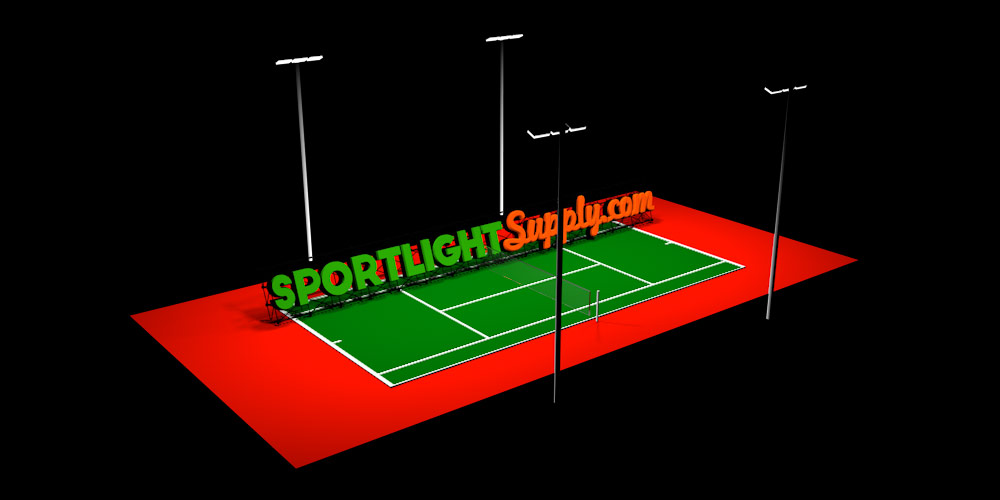
2. How many poles are used?
On a single court, this can range from a total of 4 light poles at the sides and corners to a total of 8. The more poles there are, the more likely that each light is giving more light on the court itself. This isn’t always the case if professional LED lighting is used based on pole height. Some LED fixtures can be very accurate using only 4 concentrated lamps over a court, while some require 6 lamps. For each court, it will depend on specific factors that make a tennis court location easy of difficult to light.
3. What is the average height?
For a residential court, the average industry standard tennis court light pole height is 18′- 22′ that is recommended. Taller light poles are reserved for recreational clubs are often 30′ tall. When it comes to the professional arenas, this height can exceed 50-100 feet depending on the arena design.
4. Tennis court pole light mounting
a. Poles used for outdoor courts
Outdoor courts need to have a concrete base constructed, that has exposed mounting bolts that are exposed. When electricity is used, their power supply needs to be routed from each base location. The exposed bolts are where light poles will be electrically connected and mounted. In some locations, usage of tree poles; are allowed unless construction laws specify otherwise. The exact material of each pole can be metal, molded resin, and fiber depending on the style that’s chosen.
Even preexisting metal poles can be refurnished and repainted to have a new appearance if they are old or worn looking. Pole height shouldn’t be a problem when changing-out older fixtures.
b. The ceiling mounts for indoor courts
These mounts need to be attached to an overhead beam or support that is not directly overhead of the tennis court. Along the walls is also a stylish way to mount tennis lighting if the height permits. Otherwise, the best place is mounted to the ceiling. Electrical cables can be connected by running from a path that is leading to the main electrical power box. A tennis court lighting electrician should know what the combined wattage is before connecting them.
Each light fixture will need to be attached to the ceiling mount after its secured. This is so it makes the mounting easier to attach to overhead beam supports.
Average lamp cost and installation cost of tennis court lighting. This is a question that comes down to wattage. The higher the wattage usually dictates the cost of a fixture price. Based on a 100 Watt LED light, this is roughly $120 per unit. As Watts increase, the price will be accordingly higher. Metal halide is usually cheaper and is often $50 per unit for using 1000 Watts. When brand name units are used, the cost may be higher, but the warranty will be better. This is for decades rather than years.
The installation cost is the bulk of money that is spent, as professional contractors are not cheap. It’s best to ask around and find a tennis lighting contractor that will do the job for the best asking price. Often, residential tennis court homeowners will buy all their supplies beforehand. This helps to reduce hidden price mark-ups and keep installation layout costs to a minimum.
See also: How to save money when hiring lighting contractor?
Calling a tennis court lighting contractor or making a self-installation? (Pros and Cons analysis)
The question of whether it’s a good idea to call a professional or do-it-yourself is always debatable. There are things that you might not know about electrical wiring and lighting configuration. Here are some common Pros and Cons:
1. Calling a contractor
Pros
- Fast and easy to have done on time
- Reliable work that can have a warranty
- Less worry about light configuration and handling electricity or light mounting
Cons
- Can be very expensive costing more than all the supplies for the actual work
- The work might be done sloppily if you didn’t do contractor research
- The court lighting is poorly aligned and doesn’t work how you wanted it to work
2. Self-installation
Pros
- You can always call friends who know about hooking-up electricity
- Buying lighting units and poles will be cheaper for you and your lighting design
- The total cost difference (used for a contractor) can be spent on great lighting equipment
Cons
- There might be electrical codes that are broken from your local city building codes
- The wrong kind of alignment will cost more to have a professional come and fix
- You may have bought the wrong kind of outdoor lights for your tennis court layout
Tennis court lighting Q&A
1. How many Lumens at a tennis court?
The average court that’s for a residential home measures 120 feet by 60 feet. This is 7,200 square feet of space but has 195 meters squared. This conversion requires that you’ll need 300,000-400,000 Lumens to light-up flood lights in the tennis court playing area.
2. How much does it cost to run the tennis court lighting?
This is a conversion that breaks down to how many lights you have in your tennis court. A single LED fixture costs 12 cents per day for 8 hours of light. This in turn can become $155 per light fixture. Most home courts use 4 light minimum which would be 48 cents per day for 8 hours. This results in 620 dollars per year. This is based on 8 hours at night, so realistically you might use just 4 hours per evening. This would only cost $320 per year instead.
If metal halide is used you can expect a drastic increase of $400 per lamp! This allows you to see how expensive these light really are.
3. How to replace older tennis court lighting?
Replacing older MH or HPS tennis court light is a significant energy saving that is thousands of dollars less. The power difference per LED lamp is using a 100 Watt lamp instead of 1000 Watt lamps for metal halide. It’s the same for high-pressure sodium, so your yearly savings would be nearly $1000 per year. Over 20 years this is another cost savings that earns you another $20,000 since LED lights last 20 years or more.
4. How to turn on tennis court lights?
Depending on the newly installed lighting system that is purchased, you have a choice of power options. Some tennis lighting packages allow manual lighting controls while the advanced systems can be run through a smartphone app. Having both of these controls is the best if you left your smartphone inside the house. Of course, you might have already programmed the tennis court lights to turn on automatically as a daily requirement.
5. What is the best color temperature for tennis court lights?
At home, you have a choice of choosing the color temperature that suits your liking. Sport lighting companies now offer a variety of color temperatures that come with each model. The best lights to use at home are often 2000K but aren’t limited to 4000K that’s used for professional courts. Semi-pro courts are always 4000K too, so it’s a matter of color preference. There are higher CRI and Lux used in 4000K that is stronger, which is why 2000K is more relaxing.
6. Is there a difference between residential and professional tennis lighting?
There is a difference it mainly with lighting but not because the Kelvin chart is so different. The main difference is that professional courts use specialized LED fixtures that have an anti-glare focus range. This keeps the audience and players from seeing the halo-like glare coming from high mast light poles. These large arena poles are often 50 feet above a tennis court while residential courts are seldom over 18-22 feet tall.
7. How far should light posts be placed outside a tennis court for lighting?
The most common location is 6′ outside the sidelines and 10′ behind the baselines. If a residential court measures 120 feet by 60 feet, these lights are sitting along that outside parameter. Most residential court lights use only 4 LED lights to light up their court. Fancier tennis courts may have 6-8 lights if they are semi-pro to professional players. If there are resting areas, more lighting may be added for a cocktail bar or equipment storage room.

